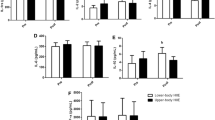Abstract
Strenuous endurance exercise in fasted subjects is accompanied by increased plasma levels of catecholamines, leucocytosis, low insulin, and elevated plasma free fatty acids (FFA). Immediately after such exercise, plasma FFA may rise to high and potentially harmful levels, whereas the white blood cell count (WBCC) rapidly decreases towards or below baseline values. The present work investigated how active recovery (AR) for 15 min at 50% of maximal oxygen consumption (\(\dot V{\rm O}_{{\rm 2max}} \) ), after 60 min of uphill running at 83% of \(\dot V{\rm O}_{{\rm 2max}} \) , influenced plasma FFA, lymphocyte, neutrophil, granulocyte, and monocyte count, as well as adrenaline, noradrenaline, insulin and cortisol concentrations until 120 min post-exercise. Thirteen endurance athletes participated in the study [24.2 (3.7) years, 1.82 (0.06) m, 76.7 (7.9) kg and \(\dot V{\rm O}_{{\rm 2max}} \) 69.2 (6.8) ml min–1 kg–1]. In a randomized order, the subjects completed two sets of strenuous workouts, followed by either AR or complete rest in the supine position (RR). Compared with RR, AR strongly counteracted the rapid increase in plasma FFA 5 min post-exercise. The decreases in neutrophil and monocyte counts post-exercise were nullified by AR, and the cell count stayed above resting values throughout the observation period. AR also counteracted the rapid return of hormone concentration towards baseline levels. It would appear that active recovery at low intensity after strenuous exercise can maintain sufficient adrenergic activation to counteract the post-exercise drop in WBCC. However, in spite of keeping the catecholamine concentration high and insulin levels low, AR can also maintain a low plasma FFA concentration, probably because of the continued use of FFA in muscle. It remains to be elucidated whether the observed high FFA and low WBCC values after RR have a negative effect on health. If so, AR could be a preventive measure.
Similar content being viewed by others
Author information
Authors and Affiliations
Additional information
Electronic Publication
Rights and permissions
About this article
Cite this article
Wigernæs, I., Høstmark, A., Strømme, S. et al. Active recovery and post-exercise white blood cell count, free fatty acids, and hormones in endurance athletes. Eur J Appl Physiol 84, 358–366 (2001). https://doi.org/10.1007/s004210000365
Accepted:
Published:
Issue Date:
DOI: https://doi.org/10.1007/s004210000365




